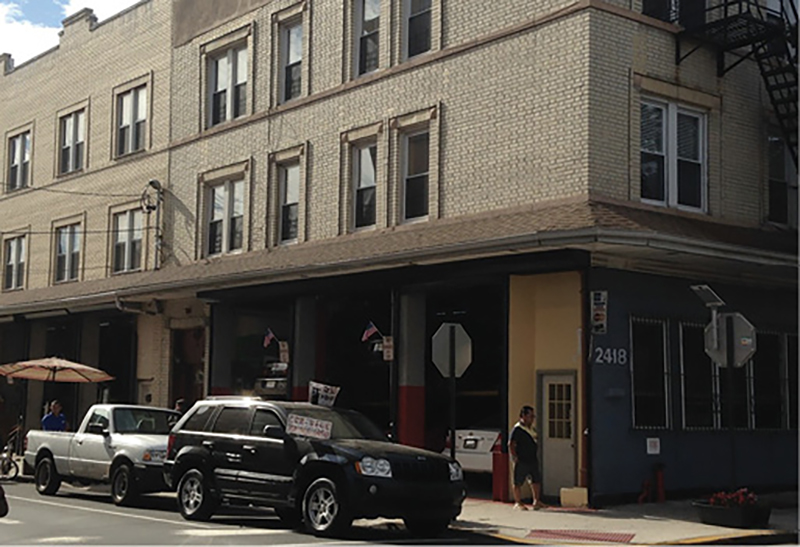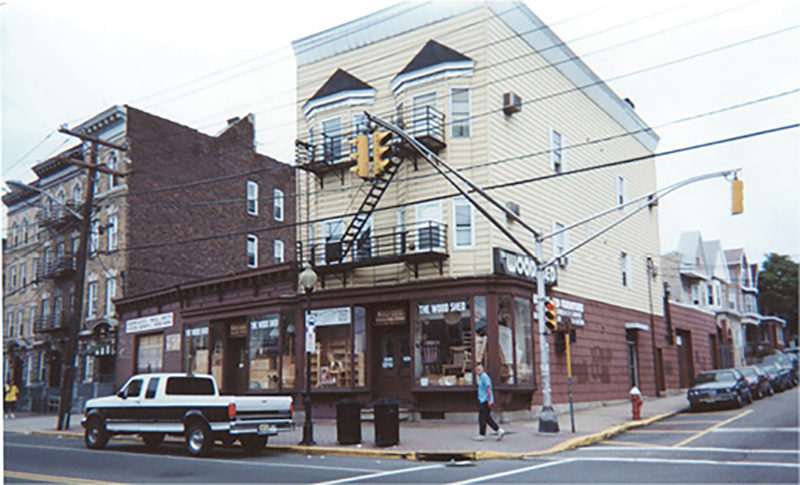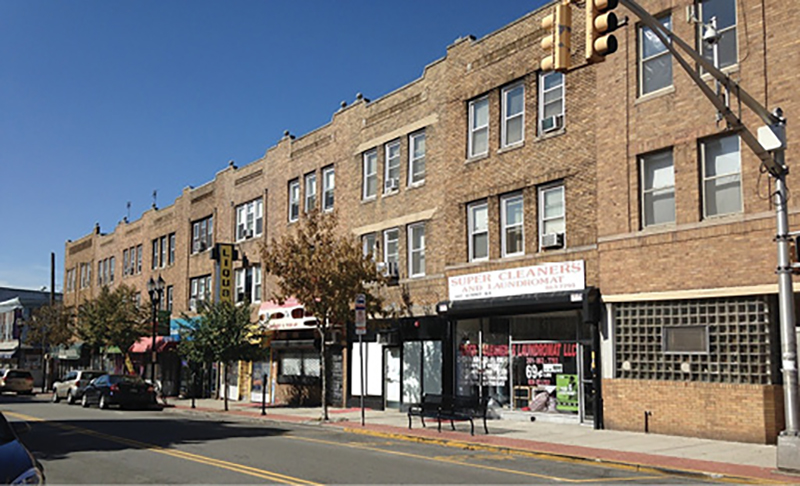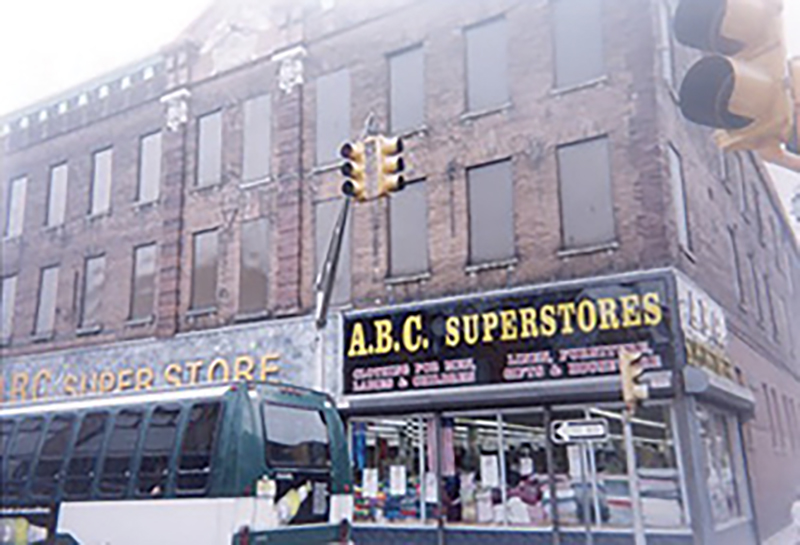Mixed-use occupancies were intended to house multiple families above a commercial occupancy. Some jurisdictions call these taxpayers. No matter what they are called, they combine the heavy fire load of a commercial occupancy on the ground floor (and maybe the cellar) with the severe life hazard of a multiple dwelling on the upper floors. Preplanning, district familiarization, and a solid on-scene size-up should guide your actions.
- Successful Response to a Chicago Taxpayer Fire
- When Buildings Change the Rules of the Game
- Building Construction Review for Firefighters
Corner Occupancies
Serious store fires, especially at night, will often be multiple-rescue, multiple-alarm events. Photo 1 shows a mixed-use occupancy with an auto repair business on the ground floor of a multiple dwelling. Who allowed this? This is an ordinary construction structure with a large cockloft. Think of the fire load, the contents’ combustibility and flammability, and how quickly a fire here will spread. Fire and smoke in the voids will quickly spread to the apartments above. There are no automatic sprinklers here.
Access to the upper-floor life hazard can be a challenge in the mixed-use occupancy. Many times, the doors to the upper-floor residential areas are not readily visible and can be difficult to find. In photo 1, the auto repair garage is on the ground floor, but the door to the right of the three garage bays is not the upstairs access door; it is the one to the left of the bays.

(1) Photos by author unless otherwise noted.
In corner buildings, access to living areas may be located on a different side of the building than the store access. Photo 2 shows another extremely heavy ground-floor fire load (The Wood Shed). Note that the door to the apartments is on the building’s D side. Note also the power lines on side A. Bring your aerial in on the D side to stick the roof here.

(2)

(3)
In photo 3, we responded to this corner mixed-use occupancy in Union City, New Jersey, where heavy fire was showing from two second-floor apartment windows. The door to the upstairs apartment is at the extreme right (the first red awning). Because of the location of the fire showing, the first-arriving engine company positioned on the street where the fire was visible. However, the windows where the fire was showing were not the address side but the structure’s B side. This positioning necessitated a longer stretch, taking more time and more hose than if the engine had positioned at the address side. Lesson learned: Respond to the address side first because it is most likely the location of access. Even though it was in the same building, the door to the store was located on a different street and had a different address. The store side only offered access to the store, not to the apartments above. Sometimes, recon will lead to operational modification, as it did here. Remember that changes to the plan often take more time, require more personnel, and allow for further fire spread and danger. Be prepared for surprises like this at corner mixed-use occupancies. Communicate!
Narrow Rear Access
Another issue arises when a block of attached mixed-use occupancies exists. Although the residential access doors may be between or adjacent to the ground-floor store doors, they also may not. If you can’t find any doors accessing the upper floors on the address side and there are no doors on the B or D side, look for an alley behind the structure. You might find the stairs and doors to the upper floors there.
Photo 4 shows a block-long row of mixed-use occupancies. Note that there are no occupancy doors in the picture, only doors to the stores. Photo 5 shows the occupancy access area on the C side. It is a narrow lane that runs behind the buildings parallel to the main avenue where the storefronts are. This is the only access to the upper-floor stairwell and apartments. Since apparatus will not fit into this alley, the stretch will be longer; any window rescues will be made using carried-in ground ladders. You will have a really tough time here if your staffing is inadequate. You must request multiple alarms early. Additionally, if the interior residential stairs also access the cellar, you must give this stairway high priority for line placement to protect the stairs and the egress. This will not be apparent if you haven’t done your homework and don’t know how to get upstairs when the apartment stairwells are remote and smoke is showing from the cellar on the A side. Poor line placement may jeopardize the life hazard above.

(4)

(5)
Renovated Structures
The concerns do not get any easier when the once-residential area is used for something else, usually storage for the business. In photo 6, a thrift store has been sealed on the top floors. These renovations will make the fire and floor load heavier, the collapse profile more significant because of the heavier floor loads, and the ability to operate on and escape from the upper floors more difficult and dangerous. Here, you will need to remove the window coverings before you can do any upper-floor operations. Although you may thereby lose control of the fire, you don’t have any alternatives. Personnel working above the fire have no second way out. We can’t employ residential, two-story, wood-frame tactics when operating in these buildings. If we do, more often than not, we will get ourselves in big trouble.

(6)
False Fronts
In photo 7, the buildings have been completely covered up with so-called false fronts. The buildings on the extreme right (Star Discounts) and extreme left (Kid’s World) are two-story structures; a false front covers the second floor. The Children’s Place is a three-story structure; a false front covers the upper two floors. These were all historically mixed-use buildings with residential units above the store. You can even see a shaft if you look toward the rear of the three-story building. Windows behind the false front can be intact or bricked-up or present any combination of barriers. Spaces will exist between the false front and building too and are additional areas for fire spread concerns. This can also create fire destruction of whatever is holding the false front to the building. Heavy smoke from behind these fronts must cause Command to seriously consider the feasibility of allowing personnel to operate in these areas. Check the rear and sides to see if access (and egress) can be gained from there. This should be a very pessimistic operation. It is tough to get a barrier-laden building to behave. Keep good control over personnel, put chief officers in areas of concern as division supervisors, and request and evaluate reports from these areas to assist in strategic decision making.

(7)

(8) Photo by Ron Jeffers.
Photo 8 shows a multiple-alarm fire in Jersey City. Note the date on top of the structure at the cornice; it says 1895. This structure eventually collapsed completely, as buildings with heavy fire involvement often do. This was once a mixed residential/commercial occupancy. The top floors have been used as part of the business and have been sealed over with what looks like corrugated steel panels. You can see the outline of the windows in the front wall. There is obviously a major fire spread threat to the upper floors. Several concerns occur here:
- Upper floors’ secondary egress is nonexistent; creating egress will take time.
- Visibility on the upper floor will be zero.
- Disorientation of fire personnel is a very real likelihood.
- Ventilation opportunities are near zero.
You must make a solid risk vs. gain assessment here—and quickly. The first-floor fire appears to be difficult to tame; the conditions upstairs are getting worse. Additionally, attached exposures with possible open cocklofts make this an even bigger challenge for Command and the operating companies. This was a tough job.
Points to Ponder
Recognize the following when working in mixed-use occupancies.
Command
- Ensure you conduct recon to find upstairs access points before committing lines and resources to the wrong location, which will delay both rescue and water on the fire.
- The egress available should be directly proportional to the risk you allow in operating on the upper floors. Limited egress = limited risk. No egress = no risk.
- Recognize light and air shafts when operating at attached mixed-use occupancies. They are a fall hazard and a fire spread hazard. Cover all areas.
Rescue
- Remember that at all hours of the day, people can be both in the stores on the ground floor and in the cellars. Ensure that you check the rear of the store. Usually, forcible entry will be a challenge in the rear, too.
- Use the fire escape rule of thumb to determine how many apartments you will need to search. Count the fire escapes on the building and multiply that by two to give you an idea of how many apartments you will have per floor. One fire escape on the building will generally mean two front-to-back apartments (railroad flats) on each floor. Two fire escapes on the building will mean four apartments, two in the front and two in the back. In photo 2, the building has a fire escape on the front and one on the rear with a gooseneck ladder leading to the roof. It has four apartments per floor.
Attack
- Be prepared for multiple line operations, especially in attached buildings.
- Use as many companies as necessary to get the first line in operation.
- In store and cellar fires, extinguishing the fire must be the priority; otherwise, you will jeopardize all upper-floor operations. Use 2½-inch lines and get water on the fire. Attempting to protect the life hazard on the upper floors by stretching upstairs first before hitting fire in the store or the cellar or protecting the residential stairwell will seriously compromise all upper-floor activities.
Ventilation
- Cellar and store fires will create heavy smoke on upper floors. Quickly conduct roof operations coordinated with water application.
- No matter where the fire is in the building, make sure to check the fire building’s cockloft and that of adjoining buildings if attached.
- At a cellar fire, cutting the floor in the store near the show windows can help direct smoke out of the building instead of allowing it to rise to the upper floors.
Extension Prevention
- Find out early if the stairway leading to the upper-floor apartments has cellar access, and ensure line protection is in place if a fire exists in the cellar. The older the building, the more likely this condition will be present.
- Again, anticipate and check for shafts at attached buildings.
- Stores often have tin ceilings, sometimes above drop ceilings. All these areas can hide and spread fire.
Always be prepared. Get out into the street and evaluate and assess these structures so that you are better educated when fire and smoke are issuing from them at 0300 hours. It is too late then. Remember, wear all your gear all the time.
ANTHONY AVILLO, M.S., is the director and deputy fire marshal at the Monmouth County (NJ) Fire Academy and an adjunct professor at New Jersey City University. A 35-year veteran of the fire service, he retired from North Hudson (NJ) Regional Fire & Rescue in 2015.


